
High Plains Gardening
The gardening website of the Texas High Plains Region
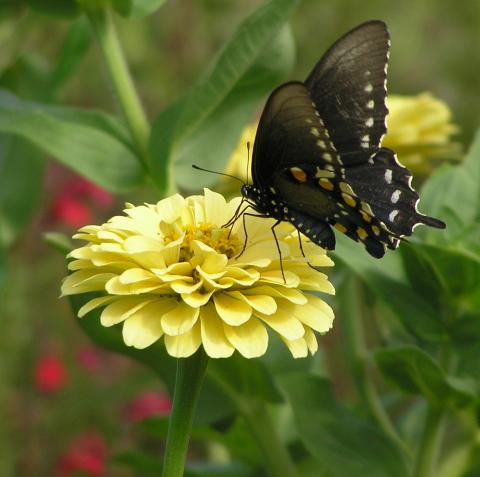 Annual plants comprise some of the jewels of the garden, used to add sparkle and interest when and where needed, in combination with shrubs and perennials. They have the ability to marry flower and foliage, color, form and texture within your existing garden, or form a garden in themselves that lasts from spring into fall. When grown from seed, this can be accomplished with minimal expense.
Annual plants comprise some of the jewels of the garden, used to add sparkle and interest when and where needed, in combination with shrubs and perennials. They have the ability to marry flower and foliage, color, form and texture within your existing garden, or form a garden in themselves that lasts from spring into fall. When grown from seed, this can be accomplished with minimal expense.
There are other reason to use annuals besides a splashy use of color in ground or in containers. Annuals fill in the space in young, immature beds and borders. More importantly now than ever, then can be used to attract and feed pollinators and other beneficial insects to create a garden more in harmony with nature.
Annual Plant Definition
The formal definition of an annual plant is a plant that completes its life cycle, from germination, through flowering, to the production of seed, within one year, and then dies. Summer annuals germinate during spring or early summer, flower, and set seed by autumn of the same year. Winter annuals germinate during the autumn, then flower, and set seed during the spring or summer of the following calendar year. The key is an annual plant will die after finishing one life cycle, while a perennial will live one or more life cycles, often many more years before dying when growing in conditions suited to that perennial. Tender annuals are annual plants that cannot take a frost, while hardy annuals survive freezing temperatures.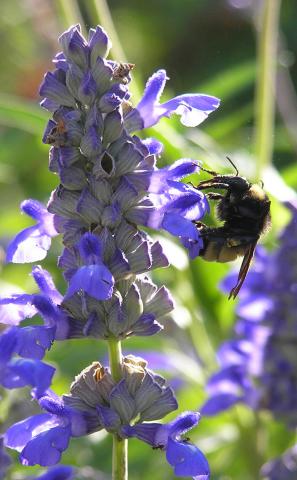
Many of the plants we call annuals are not actually annuals, but perennials. These plants could more correctly be termed tender perennials, or half-hardy perennials, as they will die with frost or freezing temperatures, yet will grow quickly and flower robustly enough the first year. Other plants are classified as biennials, needing the first year for growth and the second for flowering and setting seed. Biennials are confusing. In locations with a longer growing season, they may complete their life cycle within one year. Others can be planted in the fall, then completed in the coming growing season.
Even some tender shrubs are sold for use as annual plants, including lantanas, pelaroniums (geraniums), fuchsias, heliotropes and hibiscus. Often times our use of these plants as summer annuals are so common, we are surprised to find they are actually perennial plants. Likewise, there are a few plants used in winter: pansies, violas, and snapdragons in particular, that are perennial, but not technically winter annuals (even though that is their primary use). In a few instances, it is actually difficult to determine whether a plant is a annual, biennial or perennial because of confusing or conflicting reference information given. For convenience sake, I’ll generally refer to these plants as annuals, or plants used as annuals.
The fashion of growing annuals changes with time. Briefly, growing annuals came of age during the Victorian era, when conservatories, greenhouses or hot houses became popular. Gardeners were able to start seed of exotic plants coming into Britain from around the globe under glass with ease. Under glass, as many of our summer annuals are “tender” not frost or cold hardy. As the wealthy expanded annual plantings into expansive carpet bedding, its popularity spread far and wide to include borders of annuals for the average small lot gardener consisting of a few dozen plants. And with homeowners across the nation wanting summer color, the market responded with six packs of glorious color. And why not have a little consistent color throughout the summer!
Today, the trend is not so much carpet bedding, but integrating annuals in with perennials in mixed border schemes, using annuals to fill spaces between shrubs and herbaceous perennials and in containers. Annual vines extends this practice vertically. And the custom of outlining beds and borders with annuals will be a continuing trend, I predict.
In the Texas Panhandle, our season for warm season tender annuals begins around the first of May, a few weeks past the average date of the last frost (April 15-20th). Typically, our soil temperatures are warm enough, and its a good bet (but only a bet) it won’t freeze again until late October or November. Around this time, too, the cool season plantings begin to suffer from the heat, making May the month to change any annual beds. The last few springs brought warmer soil and air temperatures allowing for us to cheat the averages, tempting gardeners to plant early, making gardening more dangerous and exciting in the process. We’ll win some, and no doubt lose some as well.
Even for Texas Panhandle gardeners, there are a number of ways to use annuals for different purposes in the garden or containers. One theme might be to concentrate on pollinator-friendly species that attract bees, butterflies or hummingbirds. Other themes are native annuals that combine water savings with habitat-friendly qualities, or those providing more exact color, foliage, height, form and texture for specific planting schemes. Water thirsty tropical plants, most of them tender perennials that require temperatures above 55°, or above 45° for semi-tropical plants, to thrive are more and more popular, and not only in containers.
Annual plantings need not only be a garnish to the garden. Pollinator friendly annuals are becoming more and more popular today with the loss of
native habitat and widespread use of pollen-less hybrid annuals. Although some might still ask, does it attract bees?, insinuating a negative. More often than not, bee-attracting plants are viewed quite positively. Bees and butterflies (and other beneficial insects) require nectar and pollen daily for their existence. If your garden doesn't offer it, they won't come. Many annuals are bred for color, larger flowers, double flowers, longer flowering, and compact habits. These character choices breed out scent, pollen and viable seed production, functions that require a great deal of energy. So with a long season of glorious, abundant and large flowers for our viewing pleasure, the original purpose and attraction to wildlife is severed. It has been postulated that even sports of native plants that exhibit other than usual colors or attributes might not be as appealing to beneficial insects that might normally associate with the species. Sports are natural mutations that may not have the exact genes that trigger awareness in insects as do the established, prevalent species.
There exists, however, plants used for seasonal annual plantings that remain attractive to both gardener and pollinator. Just as we might search out these attributes in perennials, so might we for plants used as summer and winter annuals. Particularly, gardeners with limited bed and border space may want to select plants used as annuals that attract beneficial insects to their landscape. Gardeners have planted bee-attracting plants in and near vegetable, berry and fruit gardens to enhance pollination for ages.
 We’ve heard of the original vegetable plant guild called the “Three Sisters” guild used by Native Americans. That is, growing corn, beans and squash together to their mutual benefit. Recently a fourth “sister”, Rocky Mountain bee plant, Cleome serrulata, was identified (photo at left, courtesy of the Forest Service). Research at Anasazi settlements often finds the Rocky Mountain bee plant growing nearby – a plant used to draw bees into the garden for pollination, as well as a food source. (Wild Plants and Native Peoples of the Four Corners, p. 222-224.) New Mexico’s Tewa people mentioned the bee plant, along with corn, beans and squash in songs and blessings. (Gaia’s Garden, p. 184-185.) Other "fourth sisters" are cited as sunflowers or bee balm in other regions.
We’ve heard of the original vegetable plant guild called the “Three Sisters” guild used by Native Americans. That is, growing corn, beans and squash together to their mutual benefit. Recently a fourth “sister”, Rocky Mountain bee plant, Cleome serrulata, was identified (photo at left, courtesy of the Forest Service). Research at Anasazi settlements often finds the Rocky Mountain bee plant growing nearby – a plant used to draw bees into the garden for pollination, as well as a food source. (Wild Plants and Native Peoples of the Four Corners, p. 222-224.) New Mexico’s Tewa people mentioned the bee plant, along with corn, beans and squash in songs and blessings. (Gaia’s Garden, p. 184-185.) Other "fourth sisters" are cited as sunflowers or bee balm in other regions.
When trying out annuals, observe them to see if pollinators actually visit the plants. Many hybrids (but not all) have reduced pollen and nectar that are all but useless for this purpose. Many flowers that are in nature display single blooms but but have been hybridized to be double might be attractive to gardeners, but are not to most pollinators. But it’s important not to make snap judgments. Some bees may visit very early or late, or when we’re not around. And often we don’t see insects on their host plants unless they’re the larger, showier caterpillars such as swallowtails, or don’t recognize some of the larval stages of other beneficial insects like lady bug beetles. Observe the plants at different times of day. Botanic gardens and demonstration gardens are important observation points. If you see alot of buzzing and fluttering about your annuals, you know they are providing an important resource for pollinators.
Helping to Create a Balanced Ecology
Native and non-native pollinator friendly plants attract more than just bees and butterflies. Native plants, especially, attract many more insects, both pests and beneficial (a balanced ecology requires both) to the garden. For instance, sunflowers, native to North America, attracts over 150 species of insects, including weevils, beetles and caterpillars that feed on the all parts of the plant. But this doesn’t seem to be a problem, as over 100 of those species are beneficial predator, parasitic and pollinator insects. (Gaia’s Garden, p.159-160.) Some of the other more common beneficial insects attracted by many of these plants are lady bug beetles, tachinid flies, pirate bugs, hoverflies, parasitic wasps, big-eyed bugs and lacewings. Their interaction maintains an ecological balance, naturally sustaining the balance. The more diverse a garden is, the healthier the overall ecology will be. Pest insects may be present, but with a healthy ecology, pesticide use is not needed to preserve the balance.
Included below is a short list of some of the more commonly available annuals and plants used as annuals. There are many, many more to search out and try. They are usually available locally in seed form or plants in single or multi packs for transplant. Some may have to be ordered. Don’t be limited by this list.
One advantage to growing by seed, besides cost savings, is control. Many transplants available to gardeners are sprayed with neonicotinoids that remain in the plant for 4 months to 4 years and have 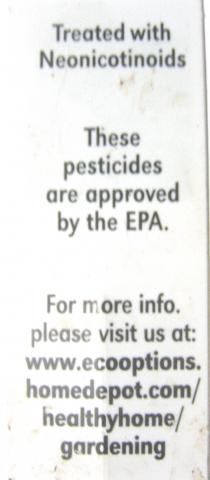 been noted as harmful to bees and caterpillars. The last several years, plant tags are noting plants that have been treated by neonicotinoids for insect pests. Under pressure from
been noted as harmful to bees and caterpillars. The last several years, plant tags are noting plants that have been treated by neonicotinoids for insect pests. Under pressure from 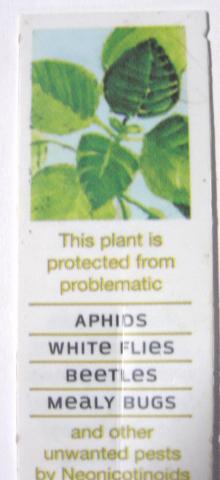 consumers and consumer groups such as Friends of the Earth, The Xerces Society and the Pesticide Research Institute, Home Depot announced in 2014 they would label plants treated with neonicotinoids. Still under pressure from consumer groups, especially Friends of the Earth, Home Depot announced in December, 2015, they have removed neonicotinoids from 80% of flowering plants and would phase out all plants treated by neonicotinoids by 2018. A further Home Depot press release made May 4, 2016, confirms this commitment by 2018.
consumers and consumer groups such as Friends of the Earth, The Xerces Society and the Pesticide Research Institute, Home Depot announced in 2014 they would label plants treated with neonicotinoids. Still under pressure from consumer groups, especially Friends of the Earth, Home Depot announced in December, 2015, they have removed neonicotinoids from 80% of flowering plants and would phase out all plants treated by neonicotinoids by 2018. A further Home Depot press release made May 4, 2016, confirms this commitment by 2018.
Lowe’s plant tags contain the caution: “ATTENTION check for “Bee Hazard” warnings and pollinator precautions on pesticide labels before application.” A check on their website revealed no information about what this means. However, after calling Lowe’s, I learned the warning is required by the EPA on their plant labels. According to a Lowe’s press release dated April 9, 2015 Lowe’s has announced they will phase out buying plants that have been sprayed or exposed to neonicotinoids: “Lowe's will phase out the sale of products that contain neonic pesticides within 48 months as suitable alternatives become commercially available. Lowe's will include greater organic and non-neonic product selections, work with growers to eliminate the use of neonic pesticides on bee-attractive plants it sells and educate customers and employees through in-store and online resources.” Other sources report Lowe’s would stop selling plants treated with neonics within four years of that announcement (by 2019).
These are two of the largest big box retailers of plants across the nation, but other suppliers are holding firm on selling plants treated by neonics. From the Minnesota Post, August 18, 2016, “Wal-Mart, Ace Hardware and True Value Hardware have declined to change their practices, the report says; a Wal-Mart spokesman told the Los Angeles Times that the company is relying on the U.S. Environmental Protection Agency to manage the problem.” In light of the EPA's recent decision not to ban chlorpyrifos, an organophosphate insecticide used as a pesticide spray of flowering plants, including food plants, even though the EPA itself has determined this chemical carries dietary and drinking water risks to humans, it is doubtful that the EPA will move to ban neonicotinoids. Chlorpyrifos is highly toxic to bees and aquatic animals.
More to Be Aware Of and Do
Six-pack gardening is convenient, and often fun. Seeing rows and rows of plants in bloom whenever walking into the nursery section of a big box store
entices one to buy. The flowers come already blooming, and here in Amarillo, at times definitely out of season. Most of these plants are sprayed, not just with pesticides, but with growth regulators that force them into bloom prematurely, stunting their size. Small-sized plants in bloom are convenient to ship, but not the most healthy or vigorous of stock for gardeners to purchase. It is unnatural for plants to bloom at 6-9 inches when they naturally bloom when 2 to 3 feet. Growing your own plants from seed or buying from growers you trust, such as Canyon’s Edge Plants, who do not use neonicotinoids and growth regulators when growing their plants, is still our best and safest option today. (Globe amaranth with Monarch photo at left; ground-nesting Calliopsis bee on desert marigold photo at right.)
Take charge of your garden's inventory and decide not to depend solely on what large international corporations decide to sell you. Search the internet for companies selling native annual seeds. Plants of the Southwest has a large selection of native, both annual and perennials. California is a rich sourch of natives can be grown here are well. It just takes a little research and trying.
Collect seeds from your plants and share with fellow gardeners. Ask fellow gardeners to share with you. Or better yet, organize a seed sharing event with gardeners or the community.
It is difficult to find information on plant on animal associations for many plants. The plants listed below have been noted to have the mentioned associations. Please keep in mind, most plants in their native environment have developed beneficial associations with microbes and insects, whether or not we have observed or published the information.
Basil, Ocimum basilicum. Tender annual herb, one of the more popular culinary herbs. Purple basil is very showy and fun to cook with. Leave basil flowers to attracts bees.
Black-eyed Susan, Rudbeckia hirta. Sometimes classified as an annual, biennial or short-lived perennial. But usually it doesn’t act like a perennial. Native yellow daisy-like summer flowers with a black center. Attracts bees, butterflies and birds. Named cultivars may have reduced pollen and nectar that does not attract pollinators.
Black-Eyed Susan Vine,Thunbergia alata. Tender evergreen perennial native to East Africa is grown as in annual outside USDA Zones 10-12. Flowers similar to our native black-eyed Susan. Attracts bees and butterflies.
Borage, Borago officinalis, hardy reseeding annual herb with intriguing star-shaped blue flowers loved by people and bees. Will grow in part shade. Edible. Photo at upper right.
Bronze fennel, Foeniculum vulgare. Annual showy edible herb is host of the caterpillar of the Eastern Black and Anise Swallowtail butterflies, ladybugs and other beneficials; the flowers attract bees. Keep deadheaded to produce more flowers. Parsley and anise attract/host similar beneficials.
Calendulas, Calundula officinalis, The pot marigold, a hardy, self-seeding, edible and medicinal annual with yellow to orange flowers. Loved by bees, hoverflies and butterflies. Sow seed direct after the last frost, deadhead to keep flowers blooming into the fall.
California poppies, Eschscholzia californica. Native hardy wildflower to California and surrounding Southwestern US. Deep golden and orange with finely cut light green foliage makes this hardy annual doubly attractive. Seed in the fall for April-June color and sometimes again in the fall. Reseeds amply, so it will appear year to year. Attracts bees. Contrasts nicely with the perennial blue flax, or the deep blue annual desert bluebell, Phacelia campanularia.
Coriander, Coriandrum sativum. Hardy annual herb. Plant in early fall for late fall and winter use when grown under a poly tunnel. Goes to seed in early spring. Attracts bees, host plant for ladybugs and other beneficial insects to your garden.
Coreopsis, Coreopsis tinctoria. Native, yellow daisy-like hardy annual attracts bees throughout the summer.
Cosmos, Cosmos bipinnatus, Tender annual flower for bees and lacewings, native to Mexico. Grows 2-5’ tall in colors of white, pink and red. Direct seed or transplant.
Cosmos, Orange, Cosmos sulphureus. Reseeding tender annual. Orange flowering with a coarser stem and leaf structure than C. bipinnatus. Don’t disturb the roots when transplanting, direct sowing is better. (Orange cosmos and butterfly at right.)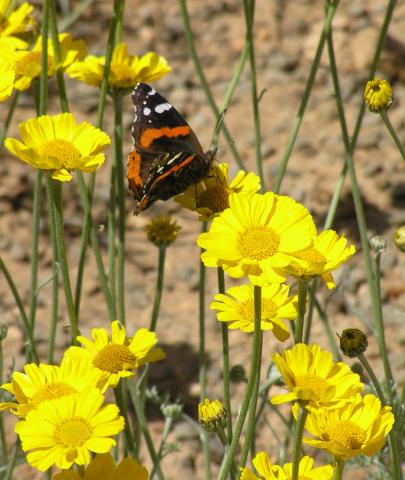
Cypress Vine, Ipomoea quamoclit. Fine textured foliage highlight this annual vine with scarlet tubular flowers that grows 10-20 feet. Attracts hummingbirds and butterflies. Cardinal vine, Ipomoea x multifida, is similar, but with larger palm shaped leaves and fewer flowers.
Desert bluebell, Phacelia campanularia. Native California annual. Deep true blue flowers in spring to June. Must be direct sowed in early spring rather than transplanted. Drought tolerant. Many Phacelia species attract bees.
Desert marigold, Baileyii multiradiata. Bees love this tender annual with deep golden daisy like flowers with silver foliage. Excellent for a xeric garden, loves the heat and can take dry conditions as it is native to the desert SW. Photo at right with butterfly.
Dill, Anethum graveolens. Hardy annual edible herb. Sow seeds direct for best results. Attracts bees; host plant for larva of swallowtail butterflies, ladybugs, lacewings and other beneficials.
Firewheel or Indian blanket, Gaillardia pulchella. SW native annual Indian blanket. Multi-colored daisy like flower that blooms in the spring through summer with ample rainfall or irrigation. Self seeding once established. Attracts butterflies, see at right.
Globe Amaranth, Gomphrena globosa. Half hardy annual from one to 2 feet tall with magenta globe, ball or button shaped shaped flowers. Globe amaranth has been hybridized to many colors, however, magenta is the original species. Some hybridized varieties do attract butterflies. Photo in section above this, with Monarch butterfly.
Heliotrope, Heliotropium arborescens. Tender perennial (tender to 40°), plant after the nights stay warm. One of the highly fragrant flowers. Loves the sun, heat, don’t overwater. Attracts bees, bumblebees and butterflies.
Icelandic poppy, Papaver nudicaul. Hardy biennial in several colors, attractive to bees. Flowers in early spring.
Poppies, Papaver ssp. All are attractive to bees. Usually sow seeds in the fall for late spring blooms. Some will self seed.
Lantana ssp. Tender shrub used as tender annual. Abundant tiny tubular flowers clustered in umbels in shades of white, yellow, orange, pink, red and purple throughout summer to frost. Native in east, west and south Texas, Arizona and into Mexico. Attracts birds and butterflies. A bed of multi-colored lantana cultivars at right.
Maragolds, Tagetes species. Tender annual. Yellow flowers attract bees and other beneficials.
Maypop, Purple Passionflower, Passiflora incarnata. Half hardy perennial vine said to be root hardy to USDA Zone 6, but in many cases doesn't winter over. But it's worth planting at least occasionally for the exotic, tropical looking blue flowers. Gulf Fritillaries love it! May attract other butterflies as well. Native to Florida and other areas of the South, including Texas.
Mealy cup sale, Salvia farinacea, a half hardy perennial. Aka Victoria salvia or the ‘Blue Bedder’ of the Victorian era. Attractive to butterflies and hummingbirds. Native to central and western Texas, and New Mexico.
Mexican Sunflower, Tithonia rotundifolia. Tender annual from Mexico for full sun. Bright orange-red flowers, plant grows to 4-6 feet, so give it some room. Butterflies, bumblebees and hummingbirds love it.
Moon Vine, Ipomoea alba. Similar to the Morning glory, only blooms at night with white flowers, making it particularly attractive to nocturnal pollinators, such as the sphinx or hawk moths.
Morning Glory, Ipomoea purpurea. Annual reseeding, twining vine with heart shaped leaves grows to ten feet. Blue flowers are the most common, but available in other colors. Attracts bees, sphinx/hawk moths and even hummingbirds.
Ornamental cabbage and kale, Brassica oleracea. Used as a fall and winter ornamental, but in our climate may freeze out. Best to use in containers and protect in winter, to bring out in spring. As the winter heats up towards spring, the plant elongates and flowers. Attractive to bees and people! Photo at right in bloom with foliage in the background.
Pentas, Pentas lanceolata. Tender shrubby perennial. Summer flowering, available in many colors. Attracts butterflies. Native to tropical East Africa and Madascar, with modern use dating back to the Victorian era. Likes sun, but benefits from afternoon shade.
Pincussion flower, Scabiosa atropurpurea. Summer and fall blooming tender or short lived perennial attracts bees. Originally the flowers were dark purple, but now can be found in most garden flower colors.
Prickly poppies, Argemone species. Annual and/or biennial spring blooming plant. Silvery green foliage with 2-4 inch flowers usually white, some species yellow. Our native annual species is Argemone polyanthemos, blooms white with a yellow center -- very attractive, bees love them, but the leaves are prickly. Photo at right of native prickly poppy taken at Wildcat Bluff.
Purple Hyacinth Beans, Dolichos lablab purpureus. Beautiful tender perennial vine. Requires frost free days. Attractive purple stems, leaves, flowers and bean seed pods to people, bees and butterflies alike.
Queen Anne’s Lace, Daucus carota. Hardy biennial exotic on the invasive plant list in the SE US. However, it attracts bees, butterflies, ladybugs, lacewings and other beneficials.
Rocky Mountain Bee Plant, Cleome serrulata, Yellow Bee Plant, C. lutea. Native hardy annual plant with summer blooming red, white or pink flowers, and the yellow bee plant blooms yellow. One of the "fourth sister" that attracts bees. Seeds are edible.
Scarlet or Texas sage, Salvia coccinea. Tender annual or short lived perennial native to the southern US, including Texas. Bright red, white or pink tubular flowers throughout summer into fall. Attracts nectar bees, butterflies and hummingbirds.
Scarlet Sage, Salvia splendens. Tender perennial with bright scarlet flowers, also known as the ‘Scarlet Bedder’ of the Victorian era, introduced from Brazil. Attractive to birds, butterflies and hummingbirds. Has been called ugly, mostly due to modern breeding making it a “squat, uniform” bedder, having had it’s ‘tall, angular grace” bred out of it. Agreed.
Snapdragon, Antirrhinum majus. Pollinated by bumblebees. Half hardy perennial that will winter over for two to three years under the right conditions. Mostly sold for early spring, as it will take a frost. Bees are more attracted to the yellow and blue hues. Larva host of the common buckeye butterfly.
Sunflower, Helianthus annuus. Very large annual flower blooms in summer and into fall in many colors and sizes. It is a host plant for ladybugs, and many beneficials, attracts honeybees, native bees and bumblebees. Also considered a "fourth sister."
Tahoka Daisy, Machaeranthera tenacetifolia (syn. Aster tanacetifolius). Native, annual tansy aster with purple aster-like flowers summer into fall, usually 6 inches to 2 ft. tall depending on conditions. Attracts bees. Tahoka daisy photo at right in the fall at Palo Duro Canyon.
Tidy Tips, Layia platyglossa. California native tender annual best sown late March and early April for blooms in May and June. Yellow daisy-like flower edged in white; extremely attractive! Plant will fade out with hot weather. Attracts butterflies.
Zinnia, various species and cultivars. Tender annuals native to Mexico, comes in tall and short sizes in nearly all colors. One of our best annuals for many garden purposes. Attracts bees and butterflies. Germinates quickly with 60°+ soil temperature, so ideal for direct seeding in late spring. Do not disturb the roots of zinnia if transplanting.
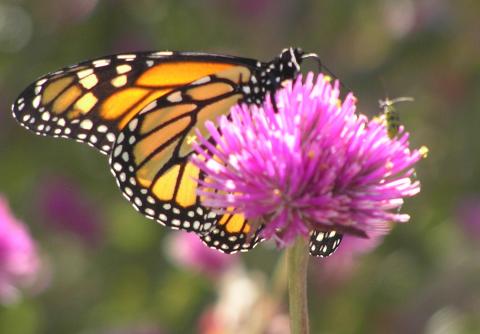
Various sources on the Internet were used to verify pollinator information.
Annuals and Biennials, Roger Phillips and Martyn Rix, Firefly books, 2002.
Annuals and Tender Plants for North American Gardens, Wayne Winterrowd, Random House, New York, 2004.
Attracting Native Pollinators, Xerces Society Guide; Mader, Shepherd, Vaughan, Black and LeBuhn, Storey Publishing, 2011.
Bees in Your Backyard, Joseph S. Wilson and Olivia Messinger Carril, Princeton University Press, 2016.
Gaia’s Garden, A Guide to Home-Scale Permaculture, Toby Hemenway, Chelsea Green Publishing, Vermont, Second Edition, 2009.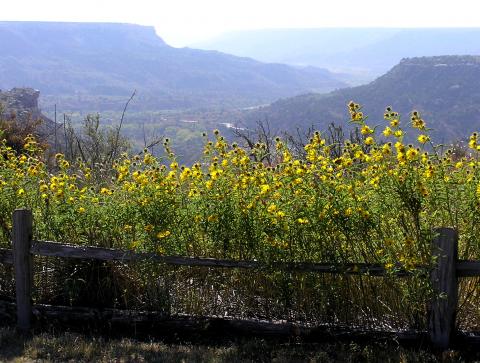
Gardening for Insects – Or Not!, Whitney Cranshaw, Colorado State University
Lady Bird Johnson Wildflower Center, Plant Data Base.
The Eco-friendly Garden: Attracting pollinators, Beneficial Insects and Other Natural Predators, by Bethany Harris, Kris Braman, Bodie Pennisi and Maria Putzke, University of Georgia campus, Griffin, GA.
The Undaunted Garden, Lauren Springer, Fulcrum Publishing, Golden, CO, 1994.
Wild Plants and Native Peoples of the Four Corners, by William W. Dunmire and Gail D. Tierney, Museum of New Mexico Press, Santa Fe, 1997.
Angie Hanna, April 6, 2017